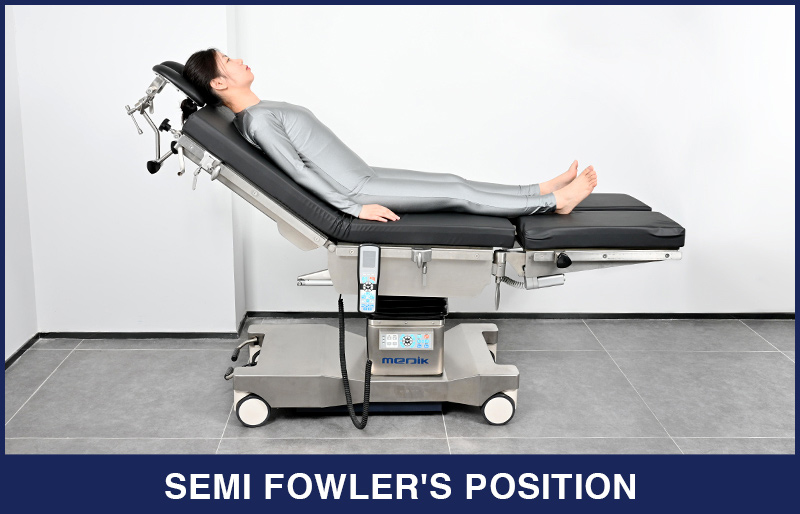

Proper patient positioning plays a critical role in ensuring safe and efficient surgical procedures. Fowler's position is one of the most common positions, which is highly prevalent for patients seeking comfort both in the hospital and emergency settings. Also referred to as the sitting position, Fowler’s positioning finds common applications in neurosurgery and shoulder surgeries. Variations of this position include Low Fowler's,
Semi Fowler's, and High/Full Fowler's, each serving different purposes.
Fowler's position offers versatile benefits, particularly for patients with respiratory difficulties. By allowing gravity to draw the diaphragm downward, this posture facilitates the greater expansion of the chest and lungs. This is especially advantageous for cases where breathing is a challenge. Learn more about Fowler’s position use cases in common medical procedures, and the differences between the positions.
When use the Fowler's Position ?
There are several situations in which medical professionals need to place an operating table or patient’s bed in Fowler’s position, such as when a patient undergoes certain types of surgery, experiences difficulty breathing, or suffers from heart failure, pneumonia, or any other respiratory distress. The exact angle at which the head of the bed or table should be set depends on the type of procedure as well as the patient’s needs and comfort.
What is Standard Fowler's Position?
Standard Fowler's position, also known as the sitting position, is commonly employed in neurosurgery and shoulder surgeries. The operating table is inclined at an angle ranging from 45 to 60 degrees, while the patient's legs may be kept straight or slightly bent. This positioning is frequently chosen for procedures involving the head, chest, and shoulders.
Standard Fowler's position is the preferred position to combat respiratory distress syndrome. By adjusting the bed's position, this Fowler's position facilitates the expanded chest expansion, thereby promoting improved breathing and oxygenation. Beyond its respiratory benefits, this position also contributes to increased drainage of blood and cerebral spinal fluid, as well as improved hemostasis.

Fowler's Position Variations
There are three variations of Fowler's position: Low Fowler's, Semi-Fowler's, and High Fowler's. These variations are classified by the angle at which the head of the bed or table is set. While all these modified versions offer the same benefits as Fowler’s position overall, they each have slightly different use cases.
1. Low Fowler's Position
Similar to the Supine Position, Low Fowler’s position entails elevating the patient’s head at an angle of 15 to 30 degrees. This position can be used post-procedure,aiding in alleviating lower back discomfort, facilitating medication administration, and reducing the risk of aspiration during tube feeding. Regarded as an optimal resting position, Low Fowler’s is often recommended for patients seeking restorative rest.

2. Semi Fowler's Position
In Semi Fowler's Position, the patient typically lies on their back with the bed inclined at an angle ranging from 30 to 45 degrees. The patient's legs can either be extended or slightly bent.
Semi Fowler's Position finds utility in scenarios where breathing difficulties arise, during breathing treatments, or when drainage is necessary post-abdominoplasty. Due to the positioning, Semi Fowler's position is the preferred position during childbirth to improve the comfort of the mother.4 Additionally, patients in the Semi Fowler's Position tend to experience reduced nausea compared to those lying flat.

3. High Fowler's Position
In the High Fowler's position, the patient is typically seated upright with their spine in a straight alignment. The upper body is elevated to an angle ranging from 60 to 90 degrees, while the patient's legs can either be extended or slightly bent. This position serves various purposes, including aiding in defecation, facilitating eating and swallowing, assisting with X-ray procedures, and enhancing breathing.
High Fowler's position is usually prescribed to elderly patients as it is scientifically proven to aid in the digestion process and help the patient overcome breathing problems.3 However, prolonged periods of rest in this position can lead to discomfort and an increased risk of pressure ulcers.

Support Devices for Fowler's position
The position is often accomplished through the use of a beach-chair table attachment such as the Orthopedic Beach Chair Positioner System. The device, which quickly attaches to standard operating tables, requires no electricity and utilizes a pneumatic cylinder to provide continuous adjustments and a rigid lock once the desired position is achieved, allowing for half of the backrest to be removed for improved access to the surgical site.
Conclusion
Appropriate patient positioning, particularly in Fowler's positions, plays a pivotal role in ensuring safe and effective surgical procedures. These positions cater to various medical needs, such as respiratory support, recovery, and comfort. However, patient-specific considerations must guide the choice of position, taking into account factors like medical history and individual comfort.
Related Resources
Reference:
https://nurse.plus/nclex-terminology/terms-abbreviations/fowlers-position/
https://healthjade.net/fowlers-position/
https://nurseslabs.com/patient-positioning/#fowlers_position